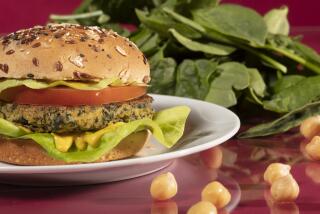How to arm yourself to make perfect paillards
- Share via
POUNDING meat is one of those kitchen tasks requiring some muscle, and the right tool makes all the difference. Too many thwacks cause tears in the meat and upper-arm distress, while the perfect pounder easily transforms a thick piece of meat into a thin slice that will cook quickly and evenly.
Kitchen stores have pounders in a number of styles. We found that in testing five on chicken breasts, their size and weight didn’t matter so much; the grip and control of the tool were more important.
The trick to pounding is not to just whack away, but to give a glancing blow as in a murder mystery, so that the mallet/pounder strikes the meat at a slight angle and sort of slides away. This prevents tearing and pulverizing.
At first we laughed at a big honker of a hammer with a thick wooden handle and a menacing aluminum top. But it was surprisingly light on its feet at 1 pound. Its size made it clunky, but it did the job well, its 2 3/4-inch head flattening the chicken uniformly.
Another wooden mallet fared OK, but it was so light -- just one-half pound -- it took extra muscle.
Hammers, though, are so yesterday. We were thrilled with the prospect of a metal tool seemingly made just for paillards with a round 3 3/4-inch head and long arm. But with each move, it felt like we were smacking the chicken, which tended to stick to it. At a little more than 1 1/2 pounds, it felt heavier -- we couldn’t get a good grip on the hard metal handle.
Thankfully, there was a stamp-style pounder. We gripped its short handle, and its nearly flat, heavy metal bottom did the work. The bottom of this pounder, which weighed 1 1/2 pounds, was rounded for even smoothing at the edges.
A similar pounder with a thick, marble bottom and round wooden handle was too heavy and hard to handle and created a suction-effect with the chicken. At 1 3/4 pounds, the pounder also left a round indent with each pound. This one might look good in a well-outfitted kitchen, but we think pounders look best in the hands of well-armed cooks.
*
The power mallet
What’s the difference: Big and brawny, this is lighter than it looks and not as Neanderthal.
What we thought: It was surprisingly easy to use, flattening meat with quick, easy blows. One of our favorites.
How much: $7.40 at Surfas in Culver City.
*
Keep pounding
What’s the difference: Light with a thin handle, this mallet is more croquet-like and not quite as serious.
What we thought: It worked well enough, but we didn’t want to have to pound quite so much.
How much: $4.95 at Sur la Table stores.
*
Good in theory, but ...
What’s the difference: Specialization. Designed for paillard-making, it had a big round head for flattening just so.
What we thought: We just couldn’t get it to do the job. Our wrists hurt, our arms hurt, our chicken took a beating.
How much: $14 to $18 at Surfas and Williams-Sonoma catalog.
*
Stamp of approval
What’s the difference: Ergonomics. This felt good as we gripped it, playfully pounding like children with rubber stamps.
What we thought: Great results with no sticking or tearing. A winner.
How much: $13.75 at Surfas.
*
Marbled good looks
What’s the difference: Weight. Heavy, unforgiving -- but hey, it looks great.
What we thought: We didn’t get the marble, which looked like something for a Roman column.
How much: $34.95 at Sur la Table stores.
More to Read
Eat your way across L.A.
Get our weekly Tasting Notes newsletter for reviews, news and more.
You may occasionally receive promotional content from the Los Angeles Times.










